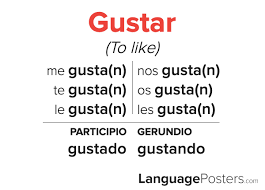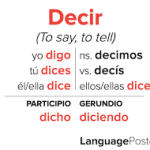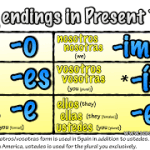Do you struggle with conjugating the verb ‘gustar’ in Spanish? Don’t worry, we’ve got you covered! In this article, we’ll show you how to confidently conjugate ‘gustar’ in the present, past, and future tenses, as well as in the imperative form.
We’ll also help you navigate the use of pronouns with ‘gustar’. Say goodbye to common mistakes and get ready to master this tricky verb!
Let’s dive in!
Understanding the Verb ‘Gustar
To understand the verb ‘Gustar’, you need to familiarize yourself with the phrase preposition ‘a ti’ and how it’s used in Spanish.
‘A ti’ translates to ‘to you’ in English and is added to the verb ‘Gustar’ to indicate the person who’s being pleased or affected by something.
It’s important to remember that in Spanish, the subject of the sentence is the thing or things that are pleasing or affecting someone, not the person themselves.
For example, if you want to say ‘I like pizza’, you’d say ‘A mí me gusta la pizza’, which literally translates to ‘To me, pizza pleases’.
Conjugating ‘Gustar’ in the Present Tense
Now let’s talk about how you conjugate the verb ‘Gustar’ in the present tense.
When using ‘Gustar’ to express likes or dislikes, it’s important to remember that the verb is conjugated differently than regular verbs. Instead of the usual subject-verb agreement, ‘Gustar’ is conjugated based on what’s liked or disliked.
To conjugate ‘Gustar’ in the present tense, you need to use the pronouns me, te, le, nos, or les, followed by gusta or gustan depending on whether the subject is singular or plural.
For example, if you like apples, you’d say ‘Me gustan las manzanas.’ If you like ice cream, you’d say ‘Te gusta el helado.’
Remember to always use the appropriate pronoun to match the subject of the sentence.
Conjugating ‘Gustar’ in the Past Tense
First, let’s learn how to conjugate ‘Gustar’ in the past tense. To express liking something in the past, we need to use the verb ‘gustar’ in its past tense form: ‘gustó’. Here’s how you can conjugate ‘Gustar’ in the past tense:
- Singular form:
- Me gustó (I liked)
- Te gustó (You liked)
- Le gustó (He/She/You liked)
- Plural form:
- Nos gustó (We liked)
- Os gustó (You all liked)
- Les gustó (They/You all liked)
Remember, the verb ‘gustar’ is used with an indirect object pronoun to indicate who likes something. The thing being liked is the subject of the sentence. So, instead of saying ‘I liked the book,’ we say ‘The book pleased me.’
Practice using these conjugations to express your past likes in Spanish!
Conjugating ‘Gustar’ in the Future Tense
You will be able to conjugate ‘Gustar’ in the future tense by using the compound preposition ‘a ti’ (to you).
To express liking or preferences in the future, simply add the appropriate form of the verb ‘gustar’ after ‘a ti’. For example, if you want to say ‘You will like the movie’, you’d say ‘Te gustará la película’.
It’s important to remember that the verb ‘gustar’ is conjugated based on the thing or activity being liked, not the person doing the liking. So, if you want to say ‘You will like the book’, it would be ‘Te gustará el libro’.
Conjugating ‘Gustar’ in the Imperative Form
Now let’s talk about how to give commands using ‘gustar’ in Spanish.
To form the imperative form of ‘gustar’, you need to use the third person singular form ‘gusta’ and add the pronouns ‘me’, ‘te’, ‘le’, ‘nos’, or ‘os’ before it.
The conjugation rules for ‘gustar’ in the imperative form are straightforward and easy to follow.
Command Forms of ‘Gustar
To conjugate ‘Gustar’ in the imperative form, use the determiner ‘the’ before the verb. When giving commands or making requests using ‘Gustar’, it’s important to remember that the verb is conjugated in the third person singular or plural, depending on the subject. Here are three examples to illustrate how to conjugate ‘Gustar’ in the command form:
- The verb ‘gustar’ + singular noun: ‘Gusta el café’ (Like the coffee).
- The verb ‘gustar’ + plural noun: ‘Gustan los libros’ (Like the books).
- The verb ‘gustar’ + infinitive verb: ‘Gusta estudiar’ (Like to study).
Conjugation Rules for ‘Gustar
To conjugate ‘Gustar’ in the imperative form, use the determiner ‘the’ before the verb.
When giving commands or instructions using ‘Gustar’, it’s important to use the correct form of the verb depending on whether you want to express a positive or negative command.
For positive commands, use the verb ‘Gusta’ followed by the indirect object pronoun ‘te’ for informal commands, or ‘le’ for formal commands. For example, to say ‘Like it!’ informally, you’d say ‘Gusta(te)lo’. For formal commands, you’d say ‘Gusta(le)lo’.
On the other hand, for negative commands, use the verb ‘No gusta’ followed by the indirect object pronoun ‘te’ or ‘le’. For example, to say ‘Don’t like it!’ informally, you’d say ‘No gusta(te)lo’. For formal commands, you’d say ‘No gusta(le)lo’.
Imperative Mood With ‘Gustar
When giving commands or instructions using ‘Gustar’, continue the discussion by conjugating the verb in the imperative form and using the appropriate determiner and indirect object pronoun.
- Use the singular form: When addressing one person, use the singular form of the verb. For example, ‘Gustame el café’ (Like the coffee).
- Use the plural form: When addressing multiple people, use the plural form of the verb. For example, ‘Gustennos los libros’ (Like the books).
- Include the appropriate pronouns: Use the indirect object pronouns to indicate who the action is directed to. For example, ‘Gustame el café a mí’ (Like the coffee to me).
Conjugating ‘Gustar’ With Pronouns
Conjugate ‘Gustar’ with pronouns to accurately express your preferences in Spanish.
When using ‘gustar’ to express what you like, it’s important to conjugate it correctly according to the pronoun used. For example, if you want to say ‘I like chocolate,’ you’d say ‘Me gusta el chocolate.’ Here, ‘me’ is the pronoun used to indicate that the liking is happening to you.
To express what someone else likes, you’d use different pronouns such as ‘te’ for ‘you’, ‘le’ for ‘he’ or ‘she’, and ‘nos’ for ‘we’.
It’s crucial to remember that the conjugation of ‘gustar’ depends on the thing being liked, not the person doing the liking.
Common Mistakes to Avoid When Conjugating ‘Gustar
One common mistake to avoid when conjugating ‘Gustar’ in Spanish is using the incorrect pronoun to indicate the person who likes something. Remember, ‘Gustar’ is a unique verb that requires the use of indirect object pronouns to express who likes something.
Here are three common mistakes to avoid:
- Using the wrong pronoun: Instead of saying ‘Me gusta’ when referring to yourself, be sure to use the correct pronoun based on the subject. For example, say ‘Te gusta’ for ‘you like’, ‘Le gusta’ for ‘he/she/you formal like’, and so on.
- Forgetting to include the pronoun: It’s essential to include the pronoun before the verb ‘gustar’. Omitting it can lead to confusion and incorrect meaning.
- Placing the pronoun incorrectly: Remember to place the pronoun before the verb, not after it. For instance, say ‘Le gusta bailar’ instead of ‘Gusta le bailar.’
Frequently Asked Questions
Can ‘Gustar’ Be Used With Plural Nouns?
Yes, ‘gustar’ can be used with plural nouns. Instead of conjugating the verb to match the noun, you conjugate it to match what is liked. For example, “Me gustan los libros” means “I like books.”
What Are Some Common Mistakes to Avoid When Using ‘Gustar’?
Common mistakes to avoid when using ‘gustar’ in Spanish include forgetting to use the correct pronoun, using the singular form with plural nouns, and not placing the indirect object pronoun before the verb.
How Do You Conjugate ‘Gustar’ in the Conditional Tense?
To conjugate ‘gustar’ in the conditional tense, you use the conditional form of the verb ‘gustar’ followed by the appropriate pronoun. For example, “te gustaría” means “you would like.”
Can ‘Gustar’ Be Used to Express Dislike?
No, ‘gustar’ cannot be used to express dislike in Spanish. It is only used to express likes or preferences. You would need to use a different verb, like ‘no gustar’, to express dislike.
Are There Any Exceptions to the Normal Conjugation Rules of ‘Gustar’?
Are there any exceptions to the normal conjugation rules of ‘gustar’? Yes, there are. The verb ‘gustar’ follows a different pattern than regular verbs. You’ll need to use indirect object pronouns.
Conclusion
In conclusion, conjugating the verb ‘gustar’ in Spanish can be a bit tricky, but with practice, it becomes easier.
It’s important to remember that ‘gustar’ is a unique verb that functions differently from other verbs.
Whether you’re conjugating it in the present, past, future, or imperative form, the key is to pay attention to the subject and the indirect object pronoun.
Avoiding common mistakes will help you master the conjugation of ‘gustar’ and confidently express your likes and dislikes in Spanish.


